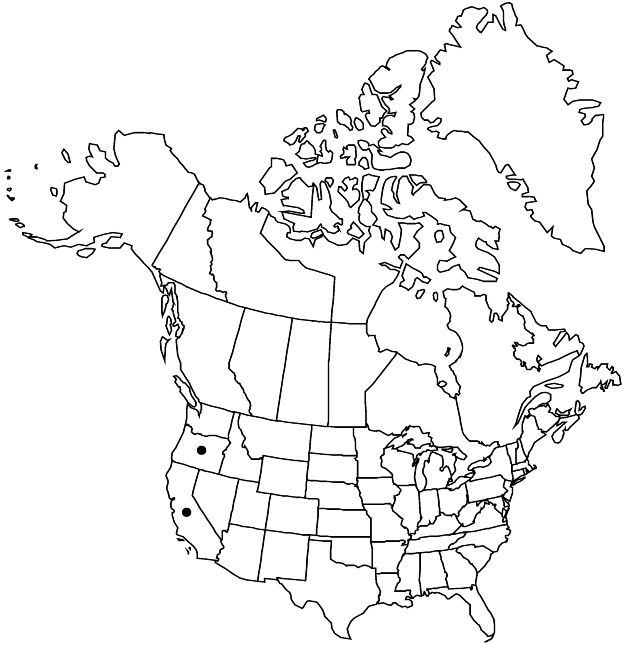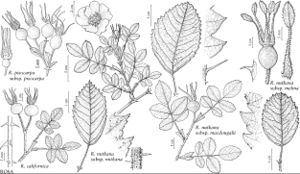Difference between revisions of "Rosa californica"
Linnaea 2: 35. 1827.
FNA>Volume Importer |
FNA>Volume Importer |
||
| Line 57: | Line 57: | ||
|publication year=1827 | |publication year=1827 | ||
|special status=Selected by author to be illustrated | |special status=Selected by author to be illustrated | ||
| − | |source xml=https://jpend@bitbucket.org/aafc-mbb/fna-data-curation.git/src/ | + | |source xml=https://jpend@bitbucket.org/aafc-mbb/fna-data-curation.git/src/f6b125a955440c0872999024f038d74684f65921/coarse_grained_fna_xml/V9/V9_164.xml |
|subfamily=Rosaceae subfam. Rosoideae | |subfamily=Rosaceae subfam. Rosoideae | ||
|tribe=Rosaceae tribe Roseae | |tribe=Rosaceae tribe Roseae | ||
Revision as of 20:35, 24 September 2019
Shrubs, usually forming thickets. Stems ascending to erect, 8–25(–30) dm, densely to openly branched; bark often glaucous when young, dark reddish brown with age sometimes exfoliating as thin ash-gray sheets, glabrous; infrastipular prickles 1–2(–3), strongly curved to nearly erect, ± flattened, stout, subulate, 3–15(–20) × 2.5–8 mm (to 10–15 mm), base glabrous, internodal prickles usually absent, sometimes sparse, smaller, aciculi usually absent, rarely stipitate-glandular. Leaves (2–)4–14 cm; stipules 5–20 × 2–5 mm, auricles flared to erect, 2–5 mm, margins entire or serrate, stipitate-glandular, surfaces glabrous, eglandular; petiole and rachis sometimes with pricklets, usually sparsely to densely hairy hairs to 1 mm, rarely glabrate, sometimes stipitate-glandular; leaflets 5–7(–9), terminal: petiolule 5–15(–20) mm, blade ovate to elliptic, sometimes obovate, (10–)15–40(–60) × 10–25(–30) mm, usually widest at or below middle, membranous to ± leathery, margins 1–2-serrate, teeth 7–20 per side on distal 3/4–4/5 of margin, obtuse to acute, eglandular or gland-tipped, apex ± obtuse, sometimes acute, abaxial surfaces pale green, sparsely to abundantly shaggy-hairy, sometimes more finely hairy and/or sparsely glandular, adaxial green, dull, sparsely hairy to subglabrous. Inflorescences panicles, few corymbs, (1–)3–30(–50)-flowered. Pedicels erect, slender, 3–20 mm, hairy, rarely glabrous, eglandular, rarely glandular; bracts 1–3, broadly lanceolate, 8–20 × 2–10 mm, margins entire or serrate, eglandular or stipitate-glandular, surfaces ± hairy, eglandular. Flowers 2.5–5 cm diam.; hypanthium ± ovoid, 4–6 × 3–5.5 mm, glabrous or sparsely hairy, eglandular, neck 1 × 2–4.5 mm; sepals spreading, ovate-lanceolate, 10–15 × 2–4.5 mm, tip 1–5 × 0.3–1 mm, margins entire, eglandular, sometimes glandular, abaxial surfaces ± hairy, eglandular, sometimes stipitate-glandular; petals single, pink, (10–)15–25 × (10–)15–25 mm; stamens 90; carpels (20–)25–40, styles exsert 1–2.5 mm beyond stylar orifice (1.5–2 mm diam.) of hypanthial disc (3–4 mm diam.). Hips scarlet, ± ovoid, sometimes globose to obovoid, 10–18 × 7–20 mm, fleshy, glabrous or ± hairy, eglandular, neck 0.5–2 × (2.5–)3–5(–6) mm; sepals persistent, usually erect. Achenes basiparietal, (1–)5–20, cream to pale brown, (3–)3.5–4.5(–5) × 2–3 mm. 2n = 28.
Phenology: Flowering Feb–Nov.
Habitat: Sunny streamsides, slough banks, mesic draws, moist areas in open woodlands, brushlands, and grasslands
Elevation: 0–1800 m
Distribution

Calif., Oreg., Mexico (Baja California).
Discussion
Rosa californica is the common thicket-forming rose in the California Floristic Province, barely entering the Mojave Desert along the Mojave River at Victorville; Oregon occurrences are problematic. Characteristics that distinguish R. californica include large compressed, often strongly curved to nearly erect prickles, shaggy leaf vestiture, leaflets most commonly ovate with obtuse apices and cuneate to rounded to subcordate bases, numerous flowers with hairy pedicels, and large ovoid hips.
Some patterns of intraspecific variation in Rosa californica correlate with the ecogeographic complexity of the California Floristic Province, and they gain significance given the extent to which the plants are used in restoration efforts. Among those ecogeographic variants that may merit taxonomic recognition are: the hartwegiana phase, comprising exceptionally robust populations in the Central Valley with consistently hooked prickles, elliptic, short-hairy leaflets with acute apices, and relatively numerous flowers; the nutkanoid phase, consisting of scattered coastal populations that combine characteristics of R. californica (for example, hip size) and R. nutkana (for example, exceptionally heavy armature); and the orthacantha phase occurring in brushlands and open woodlands around Monterey and San Francisco bays and tending to have prominent pairs of erect infrastipular prickles, 1–3 flowers on elongate pedicels that exceed the subtending bracts, and ellipsoid hips containing relatively large achenes, possibly resulting from introgression with R. gymnocarpa. Variety orthacantha C. Presl probably represents this last phase.
The Costanoans of Californian Santa Clara Valley used hip decoctions of Rosa californica for treating indigestion, sore throat, fever, colds, rheumatism, and kidney ailments, and as a wash for scabs and sores (B. R. Bocek 1984).
Selected References
None.
